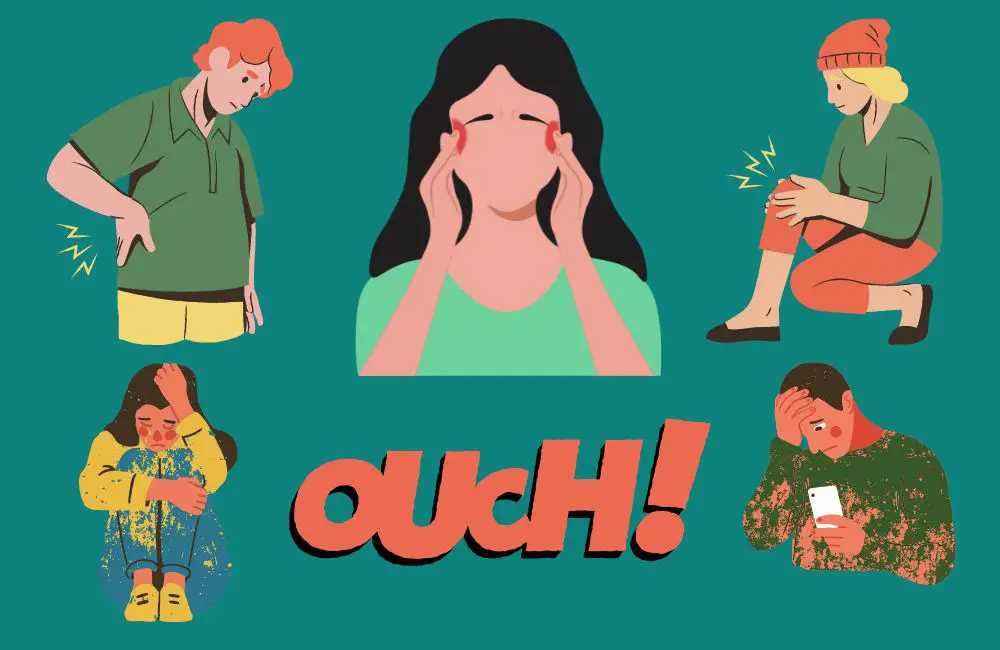For many ESL speakers, it can be challenging to express feelings, especially when it comes to describing pain: both physical and emotional. We tend to resort to simple phrases like “It hurts” or “I’m in pain”, which don’t give a clear picture of what we’re experiencing. Worry not! In this post, I’ll guide you through the different ways we can describe pain in English.
In English, describe pain by saying, “I’m suffering from unbearable pain” or “I have a slight twinge.” Physical pain can be expressed as “I felt a sudden, sharp pain” or “A persistent, dull ache is bothering me.” Emotional pain could be expressed by “I’m feeling down” or “I’m heartbroken.”
Are you looking for a book or a guide to help you learn and improve your English? You may try English Made Easy Volume One: A New ESL Approach: Learning English Through Pictures (Amazon Link).
There are many other ways to express physical and emotional pain in English. In this post, we’ll learn a number of English expressions and use them in relevant situations. Also, I’ll give some insightful tips to help you express your personal experiences more effectively.
Table of Contents
- 1. Describing Physical Pain in English
- 2. Describing Emotional Pain in English
- Tips to Describe Pain in English
- Examples of Pain Description for Specific Situations: Practice Scenario
- Sample Conversation: Describing Pain in English
- In Conclusion
- 10 Frequently Asked Questions Related to Describing Pain in English
1. Describing Physical Pain in English
Physical pain, an unpleasant sensation that can range from mild discomfort to severe distress, typically a result of injury, illness, or bodily harm. The language we use to communicate this pain can significantly impact our ability to relay our experiences accurately to others, particularly healthcare professionals.
1.1 Expressing the Intensity of Pain
The intensity of pain is a critical dimension of the experience. Describing how severe or mild your pain is can help others understand the gravity of your situation. Here are some English expressions that can help you express your pain’s intensity.
Mild Pain
- I have a slight twinge in my back.
- There’s a minor ache in my wrist.
- I can feel a faint sting on the cut.
- I’m experiencing a bit of discomfort in my shoulder.
- There’s a mild soreness in my legs from the workout.
Moderate Pain
- There’s a constant ache in my tooth.
- My arm is throbbing a bit, but it’s manageable.
- I have a persistent headache that won’t go away.
- There’s a nagging pain in my knee.
- I’m feeling a steady, moderate cramp in my stomach.
Severe Pain
- I’m suffering from unbearable pain in my head.
- This is a severe, piercing pain in my chest.
- The pain in my ankle is intense and sharp.
- I’m in excruciating pain after the fall.
- I feel a crippling pain in my lower back that’s hard to ignore.
1.2 Detailing the Type of Pain
While intensity provides one perspective, the nature of the pain offers additional clarity. By specifying the type of pain – sharp, dull, throbbing, burning, or stinging – you can provide a clearer picture of what you’re experiencing. Here are examples of how to describe different types of pain.
Sharp Pain
- I felt a sudden, sharp pain in my side as I began to run.
- There’s a sharp, piercing pain in my chest.
- The cut on my hand is causing a sharp sting.
- I have a sharp headache right behind my eyes.
- A sharp pain is jabbing my stomach.
Dull Pain
- A persistent, dull ache is bothering my neck after hours at the computer.
- There’s a dull, nagging pain in my lower back.
- I’m experiencing a dull throb in my tooth.
- My knee has a dull ache that won’t go away.
- I’m feeling a constant, dull pressure in my head.
Throbbing Pain
- I’m feeling a pulsating, throbbing pain in my tooth.
- There’s a steady, throbbing pain in my ankle.
- My headache is throbbing persistently.
- The wound on my leg is throbbing.
- My elbow has been throbbing all day.
Burning Pain
- I spilled hot tea on my hand, and it’s causing a burning sensation.
- There’s a burning pain in my eyes from the bright light.
- My throat is burning after eating the spicy food.
- The sunburn on my back is causing a burning discomfort.
- The scrape on my knee has a burning feel to it.
Stinging Pain
- A stinging pain erupted when the wasp stung me.
- The cut on my finger is stinging.
- There’s a stinging sensation in my eyes from the smoke.
- My skin is stinging from the cold wind.
- The blisters on my feet are stinging badly.
1.3 Differentiating Between Chronic and Acute Pain
The pain’s duration, whether chronic (long-lasting) or acute (sudden and severe), can also be part of your description. Here are expressions that specify the duration of pain.
Chronic Pain
- I’ve been struggling with chronic back pain for several years.
- My knee has had a chronic ache for a few months now.
- The chronic pain in my neck is a result of a car accident years ago.
- I suffer from chronic migraines that affect my daily life.
- My chronic arthritis causes constant discomfort in my hands.
- The chronic pain in my shoulder is due to an old sports injury.
- I’ve had chronic toothache for a while, and it seems to be getting worse.
Acute Pain
- I experienced acute pain after twisting my ankle.
- The cut on my hand caused an acute stinging sensation.
- I have acute back pain since I lifted that heavy box.
- There’s an acute, throbbing headache starting right now.
- I just felt an acute, sharp pain in my side.
- The burn from the hot pan is causing acute pain.
- I’m experiencing acute discomfort from the tooth I just chipped.
1.4 Using Similes and Metaphors
Similes and metaphors are creative tools that can make your descriptions more vivid and relatable. They allow you to compare your pain to common experiences, helping others to understand your discomfort better.
- The pain shot through me like a lightning bolt.
- It feels as if a thousand needles are pricking me.
- It’s as if a hammer is pounding in my head.
- It feels as if I’m being stabbed with a knife.
- The pain is like a hot iron against my skin.
- My backache is like carrying a sack of stones.
- The pain is gnawing at me like a hungry beast.
- My headache is pounding like a drum.
- It’s like a swarm of bees stinging my arm.
- The pain is roaring like a lion in my ear.
2. Describing Emotional Pain in English
Emotional pain, while less tangible than physical pain, is just as real and can be even more challenging to express. It refers to feelings of sadness, heartbreak, grief, stress, or any other emotional distress. In this section, we’ll cover different expressions and speech figures to help you effectively convey emotional pain in English.
2.1 Expressing General Emotional Pain
Generally, expressing emotional pain can be beneficial when you’re feeling down but can’t pinpoint the specific emotion. Here are more than ten expressions you can use to describe a general state of emotional discomfort.
- I’m feeling down.
- I’m heartbroken.
- I’m going through a lot right now.
- I feel like I’m carrying the weight of the world on my shoulders.
- I’m emotionally drained.
- I’m feeling out of sorts lately.
- I’m not in a good place emotionally.
- I’m struggling with my feelings.
- I’m in a state of emotional turmoil.
- I feel like I’m falling apart inside.
- I’m just not myself these days.
2.2 Describing Specific Emotions
Naming specific emotions can provide a clearer understanding of your emotional state. Here are some expressions to describe particular emotional pains.
Sadness
- I feel a deep sadness weighing me down.
- I’m filled with a profound sense of sadness.
- The sadness is overwhelming.
- I’m engulfed in a sea of sorrow.
- I’m caught in the grip of melancholy.
Grief
- I’m engulfed in an ocean of grief.
- The grief is suffocating me.
- I’m grappling with intense grief.
- I’m lost in a storm of sorrow.
- My heart is heavy with grief.
Heartbreak
- My heart feels like it’s been ripped apart.
- I’m nursing a broken heart.
- Heartbreak has torn me apart.
- I’m in the depths of heartache.
- I feel as though my heart has been shattered.
2.3 Using Similes and Metaphors
Just like with physical pain, similes, and metaphors can also be employed to describe emotional pain, making the descriptions more vivid and relatable.
- My heart feels as if it’s been shattered into a thousand pieces.
- The grief is like a dark cloud hanging over me.
- My sadness feels like an endless tunnel.
- Heartbreak is like a wound that never heals.
- My emotions are like a raging storm.
- The sadness is like a heavy chain, dragging me down.
- My heart feels like it’s trapped in a cage of despair.
- It feels as if a cold wind of sorrow has swept through my soul.
- I feel as if I’m drowning in a sea of despair.
- Heartbreak feels like being lost in a forest with no way out.
- My grief is like a shadow that never leaves me.
Tips to Describe Pain in English
Describing pain, especially when you’re communicating with someone who isn’t experiencing it, can be challenging. The English language, however, provides a plethora of words, phrases, and structures that can help you express this complex experience.
While in the previous sections, I shared several expressions to help you describe physical and emotional pain, I’ll guide you on how to use them effectively in this section. Here are ten tips to enhance your ability to describe pain in English.
#1 Be Specific
Your description of pain should be as precise as possible. Try to give a detailed picture of your pain, including its intensity, type, and duration. If it’s emotional pain, identify your feelings, like sadness, grief, or heartbreak. Clear and specific language will help the listener or reader understand your experience better.
#2 Use Comparisons
Similes and metaphors are excellent tools to convey your experience of pain. These figures of speech draw a comparison between your pain and something else, which can make your descriptions more vivid and relatable. Experiment with different comparisons to find the ones that best match your sensations.
#3 Don’t Underestimate Your Pain
It’s important not to downplay your pain when describing it. If you’re in severe pain, make sure to express it accurately. Don’t shy away from using strong language if it’s necessary to convey the intensity of your pain.
#4 Consider the Listener/Reader
When describing your pain, it’s helpful to consider who you’re communicating with. If they’re a medical professional, they may appreciate a more detailed and clinical description. On the other hand, a friend or family member may better understand simpler, more relatable descriptions.
#5 Use Physical Gestures
Combining words with physical gestures can enhance your description when talking about pain. Pointing to the exact location where you feel the pain or demonstrating the nature of the pain (like a stabbing or throbbing motion) can support your verbal description.
#6 Explore Different Adjectives
English offers a wide array of adjectives to describe sensations and feelings. Don’t limit yourself to common words like ‘hurt’ or ‘pain’. Explore other descriptive words like ‘throbbing’, ‘sharp’, ‘constant’, ‘intermittent’, etc., to accurately depict your pain.
#7 Utilize Analogies
Analogies can be a powerful way to express your pain. Describing your pain by comparing it to a well-known experience, such as “It feels like a hammer pounding in my head” can provide a clear and relatable picture of what you’re going through.
#8 Watch Your Tenses
When describing your pain, be mindful of your verb tenses. If you’re talking about a pain you’ve had for a while, use the present perfect tense (“I have had this headache for two days”). If the pain has just started, use the present simple tense (“My head hurts”).
#9 Use Pain Scales
Employing a pain scale from 1-10 can also effectively communicate the intensity of your pain. In this scale, 1 represents very mild pain, and 10 signifies the worst possible pain. This method can be particularly useful when speaking with healthcare professionals.
#10 Practice & Practice
As with any skill, the more you practice describing pain, the better you’ll get at it. Try writing or speaking about different types of pain, using a variety of adjectives and figures of speech. Over time, you’ll develop a rich vocabulary and a range of techniques for expressing your experience of pain.
Examples of Pain Description for Specific Situations: Practice Scenario
Practice indeed makes perfect, and that’s why we’ve put together several scenarios to help you master the skill of describing your health condition. In this section, we’ll look at examples of how you can describe pain in particular situations, both physical and emotional. These examples will show how you can apply the various expressions and tips discussed earlier to real-life situations.
Physical Pain
- After a long hike: “My legs are throbbing with a persistent dull ache, like I’ve run a marathon without rest.”
- Post-workout soreness: “Every muscle in my body is screaming in protest, a sharp reminder of yesterday’s intense workout.”
- After a minor kitchen accident: “I’ve accidentally cut my finger while chopping vegetables, and it stings as if a wasp has just stung me.”
- Recovering from a cold: “I’m plagued by a dull, throbbing headache, like a drummer playing a relentless beat in my head.”
- After a dentist visit: “There’s an acute, sharp pain radiating from the spot where my tooth was extracted. It feels as if someone is jabbing a needle in it continuously.”
Emotional Pain
- After a significant loss: “I’m drowning in an ocean of grief, a storm of sorrow that seems to have no end.”
- Experiencing work-related stress: “I feel weighed down by a mountain of stress. It’s like carrying a heavy load with no place to put it down.”
- After a heartbreaking breakup: “My heart aches as if it’s been shattered into a million pieces, each piece echoing the pain of heartbreak.”
- Feeling lonely: “I’m enveloped in a profound sense of loneliness. It’s as if I’m stuck in an empty room with no exit.”
- Dealing with anxiety: “I’m constantly on edge, like walking on a tightrope with no safety net. The fear gnaws at me incessantly.”
Sample Conversation: Describing Pain in English
Situation: Lisa has been experiencing recurring headaches and decides to see a doctor. During the appointment, she tries to explain the nature of her pain to Dr. Stevens.
Lisa: Dr. Stevens, I’ve been having these headaches for a few weeks now, and they’re becoming more frequent.
Dr. Stevens: I’m sorry to hear that, Lisa. Can you describe the pain for me?
Lisa: Sure. It’s a sharp, throbbing pain on the left side of my head. Sometimes it feels like a dull ache behind my eyes, and other times it’s an intense, piercing sensation.
Dr. Stevens: Does the pain radiate to any other areas or is it localized?
Lisa: It’s mostly localized, but occasionally I feel a tingling sensation down my neck.
Dr. Stevens: On a scale from 1 to 10, with 10 being the most severe, how would you rate the pain?
Lisa: At its worst, I’d say it’s an 8. It’s debilitating and makes it hard to concentrate on anything.
Dr. Stevens: Thank you for the detailed description, Lisa. This will help in diagnosing the issue. We’ll run some tests and figure out the best course of action.
In Conclusion
Learning to describe pain in English is crucial for effective communication. It might seem challenging initially, but you’ll gain confidence and proficiency with practice. This post provides you with the vocabulary and expressions needed to describe various types of physical and emotional pain.
I believe, through practicing these expressions, you will achieve the ability to express yourself clearly in English. Remember, your experiences are unique, and finding the right words to describe them is an important part of your language-learning journey.
10 Frequently Asked Questions Related to Describing Pain in English
1. What are some common words to describe the intensity of pain?
Words like mild, moderate, severe, excruciating, and unbearable can denote pain intensity.
2. How can I describe a constant pain?
You can use terms like continuous, persistent, chronic, or unrelenting.
3. How can I describe pain that comes and goes?
Terms like intermittent, sporadic, or occasional can be used.
4. Are there specific words for pain that feels like it’s moving?
Yes, words like radiating or spreading can describe such pain.
5. How can I describe a pain that’s sharp and sudden?
You can use words like stabbing, piercing, or shooting.
6. What words describe a dull pain?
Aching, throbbing, or nagging are suitable descriptors.
7. How can I describe pain that’s on the surface?
Terms like superficial, surface-level, or skin-deep can be used.
8. What about pain that feels deeper in the body?
You can use words like deep-seated, internal, or profound.
9. How can I describe pain accompanied by a burning sensation?
Burning, scalding, or searing are apt descriptors.
10. Are there words to describe pain that feels cold or freezing?
Yes, terms like chilling, numbing, or icy can be used.





